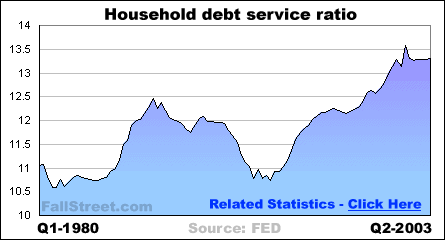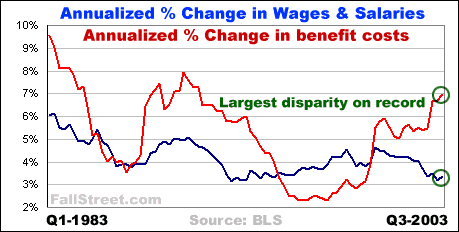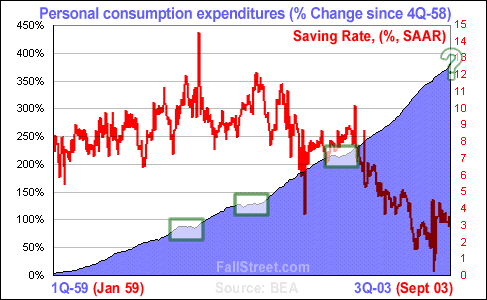
November 20, 2003
Did The Stimulus Brothers Engineer A Perfect Election Year, or A Perfect Storm?
By Brady Willett & Todd Alway
Comfortable in the knowledge that predicting a slowdown in consumer spending has become heretical, the optimists argue that consumer debt loads will be assuaged by job creation.
Electioneering rather than sound economic theory is what is driving current government intervention, and this is resulting in behavior that is potentially economically dangerous. That said, with Greenspan on board 2004 could be shaping up to be an excellent year. Long term dislocations aside, the U.S. economy may experience a continued recovery next year based solely upon the persistence and intransigence of Greenspan and Bush.
Obviously, trying to avoid the normal business cycle of creative destruction could produce long run destruction to the US economy that is less than creative. And yet the stimulus brothers’ story of how debt can be considered as synonymous with growth, of how new drivers of economic growth are manufactured via monetary and fiscal stimulus policies, is one that is exceedingly imaginative.
Part I: Keeping the Consumer’s Engine Oiled
You would think that with the average American household carrying nearly $9,000 in credit card debt, more than 50% of consumers still struggling to pay off last year’s Christmas bill, and 2003 marking a record high for personal bankruptcy filings that there would be cause for concern with regards to the health of the U.S. economy. However, to economists, stock market gamblers, Republicans, and Fed members, the statistics and surveys mentioned above are not cause for concern, but celebration.
The reason why the increasingly leveraged U.S. consumer is applauded by most is because consumers have held the fort for a long time. Indeed, for the first time ever the consumer kept spending before, during, and after an economic down cycle*. With this remarkable – some would say remarkably dangerous – spending spree in mind, the consumer has apparently held the fort until the cavalry arrived: capital spending was up smartly in 3Q03. And now that the much anticipated recovery in corporate spending has arrived consumers can take a much deserved breather and let corporate spending support the U.S. GDP machine for awhile…or so the story goes.
* The last time personal consumption expenditures declined on a quarter to quarter seasonally adjusted basis was in the fourth quarter of 1991, and the last time consumer credit contracted on annualized basis was in September 1992.
The opposing view, buttressed by a handful of naysayers who see consistently strong consumer spending as a freakish anomaly, is that this decade long spending spree could be cause for concern. Quite frankly, and unlike government deficits and stock market price-to-earnings ratios – which are still largely ignored by market participants today - a potential consumer spending fallout could be an immediate rather than longer-term worry to both policy makers and investors. Just last week Wal-Mart rocked the markets with its cautious outlook, and articles such as ‘Wal-Mart Warning Tells Us U.S. Consumer is Tapped Out’ appeared.
Even so, in light of the fact that the Fed’s recently released and adjusted debt service ratios are near record high thresholds, wage growth is abysmal, and outsourcing trends may just be beginning, the challenge is not so much figuring out why consumer leverage is a threat to the current expansion, but why so many economists ignore this threat almost completely.
 |
 |
When Failure Beckons, Stimulate!
Irregardless of the fact that consumers were only able to party during the recession because of declining interest rates, tax cuts, and the leveraging of home equity – now that the expansion has arrived the party will only continue!...
To combat the stock market meltdown and economic fallout after 9/11, Fed Chairman Greenspan started cutting interest rates and President Bush started crafting tax cut packages. Originally, and in an attempt to assuage what could potentially become a prolonged recession, these defensive stimulatory measures were aimed directly at the consumer. However, afterwards - or once stimulus measures threatened to fail – broader stimuli was directed at business (by Bush), and more aggressive tactics were deployed to encourage equity investment (i.e. Greenspan ingeniously found a way to tax money market savers).
What this stimulus has done, in the eyes of contrarians, is throw the consumer into a cycle of debt dependency that can only end in ruin. Staying away from the realm of doom, let’s just say that Greenspan and Bush kept the consumer’s motor running just when it appeared that it was about to stall.
This brief recap of the stretched U.S. consumer hardly brings many new issues to light. Yet knowing how and why the U.S. has averted a retrenched recession can better frame what Greenspan and Bush are attempting to do today. With interest rate cuts exhausted and a final tax package on its way before elections, the consumer – running red hot – is at risk of burning out. Luckily, just before this final batch of stimulus wears off, an alternative driver of growth is supposedly emerging.
 |
Part II: Different Driver, Same Pattern of Stimulus
This new driver of growth – capital spending – is significantly more unpredictable than consumer spending. To be sure, and unlike the consumer, companies can contract or increase capital spending by double digits on an annualized basis depending upon a number of variables, including interest rates/spreads, balance sheet leverage, consumer demand (capacity), market liquidity, and technological competitiveness.
Unpredictability aside, the stimulus brothers have united in a common cause: by promising to keep interest rates at historically low levels until the economy starts causing sparks, Greenspan has forced companies to borrow now (before rates head higher), while Bush has offered 1-time tax incentives that are directly aimed at businesses. For example, Bush is permitting smaller businesses to declare up to $100,000 in capital spending deductions (as opposed to $25,000) in 2004. Moreover, for capital spending greater than $100,000 - up to $400,000 – businesses can claim the first $100,000 plus 50 percent of the remainder. With Greenspan and company reluctant to raise interest rates before jobs growth arrives, and Bush’s once in a lifetime capital spending incentives disappearing in 2005, the table has certainly been set - or slanted, if you prefer.
Trying To Get Ahead For Fear of Being Left Behind
If the world behaved exactly like economists tell us it should, a company would invest money on the basis of a strengthening demand for its products or services. However, few things in the business world behave as they should – especially where the government has intervention in mind. Rather, with capacity mired near all time lows, the impatient stimulus brothers have concocted a series of complex reasons for capital spending to increase beyond demand considerations. Think about the implied party line -- if you own a business and didn’t borrow and/or increase investment today, wouldn’t you be kicking yourself tomorrow? Why? Because the markets are suggesting that interest rates are headed higher, commodity prices are suggesting that inflationary pressures are building, and both Greenspan and Bush are suggesting that they have done, and will continue to everything possible to stimulate recovery. In short, waiting until 2005 to start borrowing and spending could prove costly to your businesses!
The idea that companies are borrowing and spending more money to beat the curve is completely understandable. Even so, while borrowing makes sense, what ultimately determines whether investing makes sense is return on invested capital.
Sacrificing Tomorrow For Next Years Votes?
Be it Democrats or former Treasury Secretaries (Rubin), many have questioned how successful Bush and Greenspan will be in sparking a sustainable economic recovery. And while fears over Greenspan backed bubbles (i.e. stocks and housing) and government deficits are the most common dangers mentioned, a series of other events – undertaken to perhaps buy votes rather than in an attempt to set sound policy – have also come into focus. These issues, including steel tariffs, newly enacted textile tariffs (China), and a brief concerted attack against the Chinese Yuan, have reignited protectionism fears…fears that are doubly dangerous given the U.S.’s increasing reliance on foreign investment.
In The End: Looking Two Steps Ahead
Economists long to place trends in both consumer and capital investment into cycles. We would argue that this has become increasingly difficult to do because consumer spending has not suffered through recession since the early 1990s, whereas business investment as been in a funk since 2000.
Yes, thanks to enlarging federal budget deficits and what could potentially be a firm year for capital investment, some of the pressure has been taken off of the U.S. consumer. Nevertheless, it is worth remembering that just as the consumer’s cycle of debt dependency could ultimately prove to be treacherous, increases in capital spending can, similarly, prove dangerous if consumer spending buckles. Beating the curve may seem like a self fulfilling prophesy, but it is a prophesy that hinges upon a continued spending spree.
Why? Well, by investing in technological upgrades businesses are increasing efficiencies and thereby increasing their potential capacity. The problem here is that current capacity utilization is mired at 75%. With a rebound in consumer spending unable to take place (since it has never declined to begin with) where is the increased demand necessary to generate this ROIC to come from?
Incidentally, the stimulus brothers’ actions are not exactly aimed at encouraging companies to spend. Rather, they are geared towards causing enough traction in overall aggregate demand to compel companies to hire more employees. To be sure, in order for the broader cycle of debt dependency to swing downwards more Americans must be employed.
One readily realizes why Bush is anxious to trigger a strong economic recovery no matter how dangerous this might be in the long run to corporate profitability - excess capacity and an excessively debt-leveraged consumer does not a sound economy make. By contrast, one can only hope that Greenspan isn’t promoting malinvestments before that of the 1990s has been eradicated. After all, how can borrowing and spending now make so much sense for companies if the outlook for demand is uncertain?
But alas, demand is never uncertain – the U.S. consumer will keep spending…or so the story goes.
In sum, if capital spending cannot be sustained, and if the burden of keeping the U.S. economy stimulated falls directly on the shoulders of the government as consumers spend through what could be their last tax rebate in early 2004, the outlook leading into and beyond the elections could turn perilous. To be sure, the threat is that one day soon – when overly optimistic forecasts for consumer spending and the curve driven gains in capital spending have been expunged – market participants will awake and see a weak economy bleeding red: an economy buffeted by a low-demand gale made more intense by government electioneering.
BWillett@fallstreet.com
tjalway@connect.carleton.ca
a